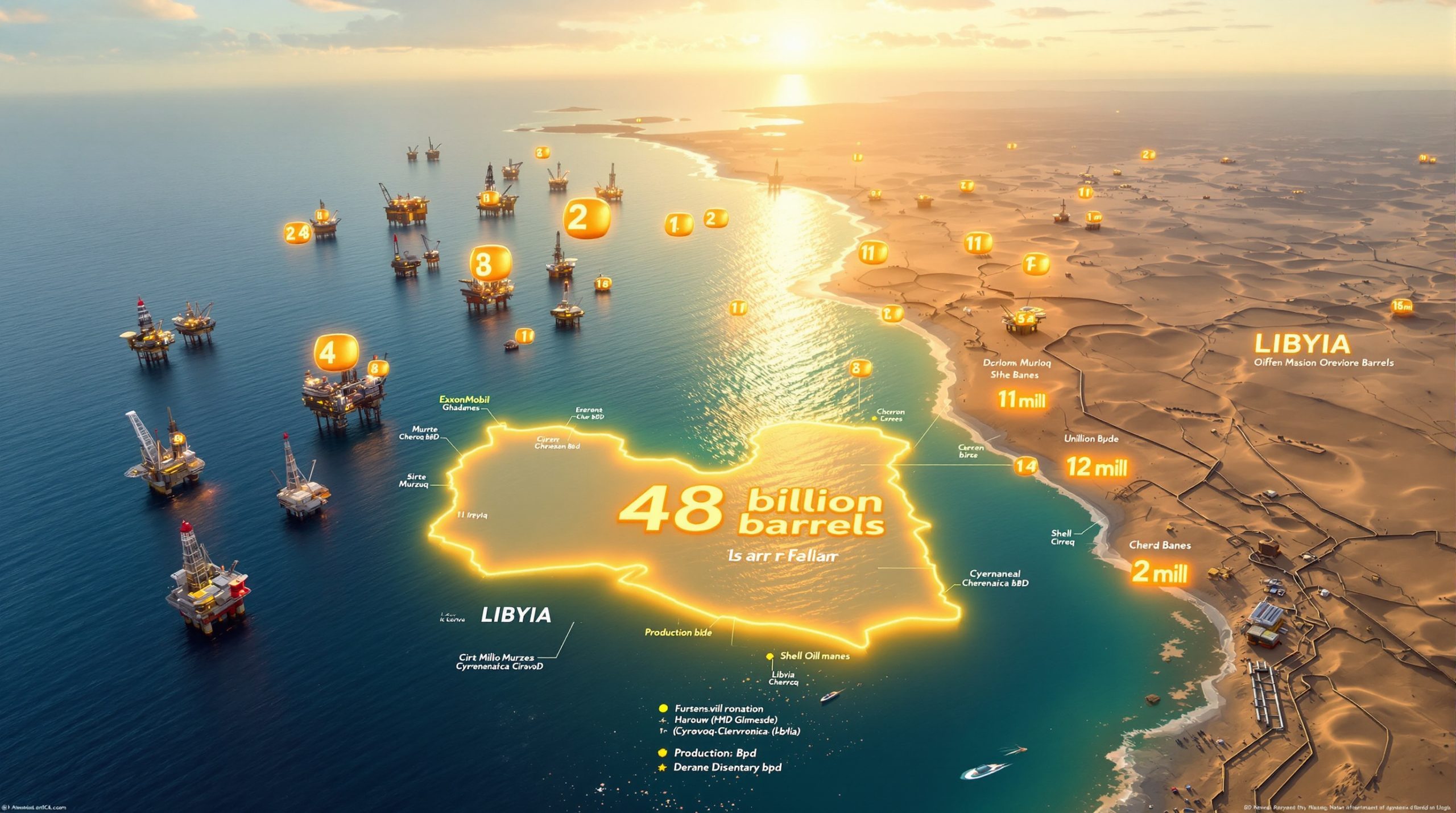Strategic Forces Reshaping Libya's Energy Investment Landscape
Global energy markets face unprecedented volatility as major hydrocarbon producers navigate geopolitical tensions, infrastructure constraints, and shifting demand patterns. Within this complex environment, frontier oil provinces emerge as critical battlegrounds for international operators seeking to diversify portfolios and secure long-term reserves. Strategic scenario analysis reveals that successful companies must evaluate multiple risk-return pathways simultaneously, incorporating technical feasibility, political stability metrics, and capital allocation efficiency into comprehensive investment frameworks.
Libya's energy sector represents a fascinating case study in this dynamic, where 48 billion barrels of proven reserves position the nation as Africa's largest hydrocarbon resource holder. Current production levels of 1.4 million barrels per day could potentially expand to 2 million bpd within three years, contingent upon sufficient capital investment and operational stability. This production trajectory places the Libya oil exploration bid round among the world's most significant oil expansion opportunities, particularly given its strategic Mediterranean location and proximity to European refining centers.
What Makes Libya's First Exploration Tender in 18 Years a Game-Changer?
The Strategic Context Behind Libya's Energy Sector Revival
Libya's hydrocarbon endowment fundamentally differentiates it from regional competitors across multiple dimensions. With proven reserves of 48 billion barrels, the country maintains a substantial advantage over Algeria's 12.2 billion barrels, Egypt's 3.3 billion barrels, and Nigeria's 37 billion barrels. This resource base, combined with high-quality crude oil grades and established infrastructure networks, creates compelling economics for international operators evaluating African opportunities.
The timing of Libya's market re-entry reflects broader strategic considerations beyond immediate commercial returns. Following 18 years since the previous bid round in 2007, the current tender represents the first major liberalization initiative since Muammar Gaddafi's overthrow in 2011. This extended absence period allowed global energy markets to evolve significantly, with technological advances in deepwater drilling, enhanced oil recovery techniques, and digital reservoir management creating new possibilities for resource extraction.
Furthermore, recent developments in Saudi exploration licenses demonstrate how regional energy policies influence global investment patterns. Infrastructure advantages near existing production facilities provide immediate operational benefits that distinguish Libya from other frontier markets. Unlike greenfield developments requiring extensive new pipeline systems and processing facilities, Libya's offered acreage connects to proven transportation networks, export terminals, and established supplier ecosystems.
This infrastructure proximity can reduce development timelines by 3-5 years compared to entirely new oil provinces. Moreover, the impact of commodities market volatility has heightened interest in stable production bases with established infrastructure.
Bid Round Mechanics and Commercial Framework
The 22-block structure, comprising 11 offshore and 11 onshore exploration areas, reflects sophisticated resource portfolio optimization designed to attract diverse operator profiles. Offshore blocks target international majors with deepwater technical capabilities, while onshore opportunities suit companies prioritizing faster development cycles and lower technical risk profiles.
Libya's revised production-sharing agreement terms represent a significant evolution from historical contract structures. The National Oil Corporation has implemented more attractive fiscal conditions compared to pre-2011 frameworks, including:
- Enhanced cost recovery mechanisms for exploration investments
- Improved profit oil splits favoring international operators
- Streamlined regulatory approval processes for development activities
- Reduced signature bonus requirements to encourage broader participation
Basin-specific opportunities span Libya's most prospective geological formations. The Sirte Basin remains the country's most prolific hydrocarbon province, containing approximately 80% of proven reserves. The Ghadames Basin offers significant gas potential with proven commercial discoveries, while the Murzuq Basin presents frontier exploration opportunities in largely underexplored regions.
The Cyrenaica-Sirte Basin combines proven production areas with extensive step-out potential. According to Libya Business Insider, major international companies have already qualified for participation, demonstrating significant industry interest.
How Do Major Oil Companies Evaluate Libya's Risk-Reward Profile?
Corporate Strategy Assessment Framework
ExxonMobil's four-block offshore focus reflects the supermajor's preference for large-scale, technically complex projects that leverage its deepwater expertise. The company's preliminary memorandum of understanding specifically targets offshore acreage where its advanced seismic interpretation capabilities and subsea development technologies provide competitive advantages. This strategic positioning aligns with ExxonMobil's portfolio optimization toward high-margin, long-life assets.
Shell's al-Atshan field evaluation represents a brownfield development approach that minimises exploration risk while maximising near-term production potential. The comprehensive technical and economic feasibility study encompasses full field development scenarios, leveraging existing infrastructure and proven reservoir characteristics. This strategy reflects Shell's emphasis on capital-efficient projects with accelerated payback periods.
Chevron's country-entry decision matrix incorporates Libya within a broader "new country entry" strategy focused on portfolio diversification beyond traditional North American and European operations. CEO Mike Wirth's acknowledgement of Libya opportunities during investor day presentations signals board-level strategic commitment to evaluating the country's commercial potential within Chevron's global asset portfolio.
Investment Threshold Analysis
Capital allocation priorities for international majors increasingly emphasise projects delivering internal rates of return exceeding 15% at $60 per barrel oil prices. Libya's competitive position stems from relatively low development costs compared to deepwater offshore projects or unconventional resource plays. Preliminary economic assessments suggest Libya developments could achieve attractive returns at oil prices $10-15 per barrel below equivalent projects in other frontier regions.
Libya positioning versus other frontier markets reveals distinct advantages and challenges compared to leading exploration provinces:
| Frontier Market | Estimated Development Costs | Time to First Oil | Political Risk Rating |
|---|---|---|---|
| Libya | $15-25 per barrel | 3-5 years | Moderate-High |
| Guyana | $25-35 per barrel | 5-7 years | Low-Moderate |
| Mozambique | $30-40 per barrel | 7-10 years | Moderate |
| Suriname | $20-30 per barrel | 4-6 years | Low |
Timeline expectations vary significantly across different development scenarios. Exploration success to first oil timelines depend heavily on infrastructure proximity and reservoir characteristics. Libya's established pipeline networks and export facilities could enable first oil within 24-36 months for discoveries near existing infrastructure, compared to 5-7 years for entirely new development areas.
What Geopolitical Scenarios Could Impact Exploration Success?
East-West Libya Division Implications
The Government of National Unity (GNU) based in Tripoli maintains international recognition and control over western Libyan territories, including key oil production facilities and export terminals. However, operational reality reveals more complex territorial control patterns that directly impact hydrocarbon operations.
Libyan National Army (LNA) forces loyal to Khalifa Haftar exercise practical control over eastern regions containing several of Libya's key oil-producing fields and export terminals. This territorial fragmentation creates operational challenges for international operators, as noted by senior Libyan official Mahmoud Ahmed Alfiste: while the National Oil Corporation is internationally recognised as the sole legitimate custodian of Libya's production and exports, "Haftar and his sons are controlling" areas with critical reserves.
Infrastructure access challenges in Haftar-controlled eastern regions require careful operational planning and stakeholder engagement. International operators must navigate relationships with both the internationally recognised NOC and local authorities controlling physical assets. This dual-authority structure has historically led to production shutdowns and export disruptions when political tensions escalate.
Western Strategic Partnership Considerations
U.S.-Libya energy diplomacy objectives centre on positioning Libya as a reliable alternative to Russian oil supplies within Mediterranean and European markets. The US policy change on PDVSA illustrates how American energy diplomacy affects global supply chains. The timing of senior Libyan officials' Washington visit in late November 2025 coincides with broader Western efforts to diversify energy supply chains away from Moscow's influence.
European energy security diversification strategies view Libya as a critical component of reduced Russian energy dependence. Libya's geographical proximity to European refining centres and existing pipeline infrastructure provide natural advantages for serving EU markets. Finance Minister Khaled Al-Mabrouk emphasised this strategic positioning, stating expectations for "substantial and sustained dialogue with U.S. partners to invest in Libya's transformation" supporting "a unified, stable Libya that benefits both countries' strategic interests."
Russian influence dynamics following Syria developments have intensified Moscow's focus on maintaining strategic footholds in North Africa. Following Bashar al-Assad's fall in late 2024, Russia shifted increased attention to Libya as a critical Mediterranean influence zone. This geopolitical pivot creates competitive dynamics between Western and Russian interests in Libya's energy sector development.
In addition, the ongoing US‑China trade war effects influence global energy investment flows and strategic partnerships.
Which Exploration Blocks Offer the Highest Commercial Potential?
Offshore Block Evaluation Criteria
The 11 offshore blocks span diverse geological settings from shallow continental shelf areas to deeper Mediterranean waters. ExxonMobil's four-block memorandum of understanding focuses specifically on offshore acreage, suggesting the supermajor's geological and geophysical assessments identify superior commercial potential compared to onshore alternatives.
Proximity to European export markets provides immediate commercial advantages for offshore discoveries. Mediterranean deepwater prospects offer direct access to European refining centres without transit through potentially unstable overland pipeline systems. However, shallow continental shelf opportunities may provide faster development timelines and lower technical risks.
Technical complexity varies significantly across offshore block portfolio. Deepwater blocks require advanced subsea development capabilities and sophisticated floating production systems, while shallow water areas enable conventional platform development approaches. Development cost considerations suggest shallow water projects could achieve first oil 18-24 months faster than deepwater alternatives.
Onshore Block Strategic Advantages
Existing infrastructure connectivity provides immediate operational advantages for onshore development opportunities. The Ghadames Basin, where Eni resumed exploratory drilling in October 2024, demonstrates this infrastructure advantage through proven pipeline connections and established field development networks.
Security considerations across different regional territories create varying risk profiles for onshore operations. Western regions under GNU control offer more predictable operational environments, while eastern areas under LNA influence require additional stakeholder management and security protocols. However, some of Libya's most prolific oil-producing areas remain in eastern territories.
Fast-track development potential enables near-term production opportunities for discoveries in areas with existing processing facilities and pipeline networks. The BP assessment of Messla and Sarir fields exemplifies this approach, focusing on proven productive regions where additional development can leverage existing infrastructure investments.
How Could Libya's Production Expansion Affect Global Oil Markets?
Supply Chain Integration Scenarios
Libya's path from current 1.4 million bpd to targeted 2 million bpd production requires coordinated expansion across exploration, development, and infrastructure systems. This 600,000 bpd increase would represent approximately 0.6% of global oil production, potentially impacting regional supply-demand balances and pricing dynamics.
The impact of Libya's production expansion should be considered alongside developments from the OPEC production meeting and broader market dynamics. Timeline analysis suggests realistic production ramp-up scenarios depend heavily on exploration success rates and infrastructure development pace. Optimistic scenarios could achieve 2 million bpd within 3-4 years, while conservative projections extend timelines to 5-7 years accounting for potential political disruptions and technical challenges.
Integration with existing Libyan oil marketing and export systems requires infrastructure expansion and modernisation investments. Current export terminal capacity and pipeline throughput capabilities may require $2-3 billion in additional infrastructure investments to handle increased production volumes efficiently.
Market Position Strengthening Analysis
Libya's role in OPEC+ production dynamics becomes increasingly significant as output expands toward 2 million bpd. This production level would position Libya among the top 10 global oil producers, potentially influencing OPEC quota allocations and production coordination agreements.
Competition with other African oil exporters creates both challenges and opportunities within global market positioning. Nigeria's production instability and Angola's declining output provide market share opportunities for stable Libyan production growth. However, Algeria's pipeline capacity expansion and Egypt's offshore discoveries create competitive pressures within Mediterranean oil markets.
European refinery crude slate optimisation opportunities favour Libyan light, sweet crude grades that command premium pricing relative to heavier, higher-sulfur alternatives. Libya's API gravity of 36-39 degrees and sulfur content below 0.5% align perfectly with European refining specifications and environmental regulations.
What Investment Risks Should Companies Consider?
Political Stability Assessment Framework
Government continuity scenarios require careful evaluation of both GNU legitimacy and LNA territorial control sustainability. The current relatively calm security situation represents a significant improvement from post-2011 civil war conditions, but institutional fragmentation persists. Contract sanctity depends on maintaining relationships with both internationally recognised authorities and local power structures.
Regional conflict spillover potential encompasses several risk vectors, including:
- Libyan civil conflict re-escalation between eastern and western factions
- Sub-Saharan migration pressures creating social and economic tensions
- Tunisia and Algeria political instability affecting regional security dynamics
- Mediterranean geopolitical competition between Western and Russian influence spheres
International sanctions risk evaluation must consider potential targeting of individuals or entities controlling oil infrastructure. While current sanctions primarily focus on specific individuals rather than sectoral restrictions, escalating political tensions could expand sanction scopes affecting commercial operations.
Operational Risk Mitigation Strategies
Security infrastructure requirements vary significantly across operational areas. Western regions may require standard industrial security protocols, while eastern territories could necessitate enhanced security measures including armed protection for personnel and facilities.
Local content and employment obligations typically require 30-40% Libyan workforce participation and local supplier preference programmes. These requirements can create operational challenges but also provide community engagement benefits that enhance social licence to operate.
Environmental and social governance compliance frameworks must address both international standards and local community expectations. ISO 14001 environmental management systems and IFC Performance Standards provide baseline requirements, while community development programmes ensure sustainable stakeholder relationships.
Key Success Factors for February 2026 Bid Submissions
Technical Capability Requirements
Advanced exploration technology capabilities prove essential for competitive bid submissions across both onshore and offshore blocks. 3D seismic interpretation software, deepwater drilling expertise, and enhanced oil recovery techniques differentiate successful operators from less competitive alternatives.
Local partnership strategies enable international operators to navigate complex stakeholder relationships and regulatory requirements. Joint ventures with Libyan Investment Authority or other local entities provide political risk mitigation whilst satisfying local content requirements.
Regulatory compliance expertise encompasses understanding both international oil industry standards and Libya-specific legal frameworks. Companies must demonstrate familiarity with Libyan Petroleum Law, tax regulations, and environmental compliance requirements within bid submissions.
Financial Structure Optimisation
Capital commitment levels require careful balance between demonstrating serious investment intentions and maintaining financial flexibility for project execution. Successful bidders typically propose phased investment approaches with initial exploration commitments of $50-100 million per block and conditional development investments based on discovery success.
Risk-sharing mechanisms with international partners provide capital efficiency and risk diversification benefits. Joint venture structures with complementary technical capabilities or farm-out agreements with financial partners optimise capital allocation whilst maintaining operational control.
Currency and fiscal stability considerations require sophisticated financial planning given Libya's economic challenges. U.S. dollar-denominated contracts, international arbitration clauses, and political risk insurance provide protection against economic instability and policy changes.
Long-term Strategic Implications for Libya's Energy Future
25-Year Vision Implementation Pathways
Libya's ambitious 8 billion barrel reserve addition targets require sustained exploration success rates significantly exceeding historical averages. Achieving this objective necessitates discovering approximately 320 million barrels annually over 25 years, demanding extensive exploration programmes across multiple geological basins.
Technology transfer and local capacity building requirements create opportunities for sustainable industry development beyond immediate commercial returns. Training programmes for Libyan engineers, local supplier development initiatives, and technical university partnerships establish foundations for long-term sector growth.
Sustainable development integration with oil sector growth addresses environmental and social governance expectations whilst supporting economic diversification objectives. Carbon capture and storage projects, renewable energy integration, and local community development programmes demonstrate responsible resource development approaches.
Regional Energy Hub Development Potential
Trans-Mediterranean pipeline expansion possibilities could position Libya as a critical energy transit corridor linking North African production with European consumption centres. Proposed pipeline projects connecting Libya with Italy, Greece, and other Mediterranean markets could handle 2-3 million bpd additional capacity beyond domestic production.
Renewable energy integration with hydrocarbon infrastructure creates synergistic development opportunities leveraging existing industrial assets. Solar power facilities utilising oil field infrastructure and hydrogen production projects using natural gas resources demonstrate potential energy transition pathways.
Economic diversification opportunities beyond oil dependence require coordinated development of manufacturing, services, and technology sectors. Oil revenues can finance education, infrastructure, and industrial development projects creating sustainable economic growth foundations independent of hydrocarbon cycles. Energy Capital Power's comprehensive guide provides detailed analysis of Libya's licensing framework and investment opportunities.
Furthermore, the Libya oil exploration bid round represents a pivotal moment for the country's energy sector transformation. This opportunity arrives at a crucial time when global markets seek energy security and diversification. Successful implementation of this Libya oil exploration bid round could fundamentally reshape North Africa's role in global energy markets.
Important Note: This analysis contains forward-looking statements and scenarios based on current available information. Political developments, security situations, and market conditions in Libya remain subject to rapid change. Investors should conduct comprehensive due diligence and consult with regional experts before making investment decisions in Libya's oil exploration bid round or related activities.
Ready to Discover the Next Major Oil Play?
Discovery Alert's proprietary Discovery IQ model delivers instant notifications on significant ASX mineral discoveries and energy sector opportunities, empowering investors to identify actionable prospects before broader market recognition. Explore why major discoveries can generate substantial returns by examining historical success stories, then begin your 30-day free trial today to position yourself ahead of the market with real-time investment alerts.




